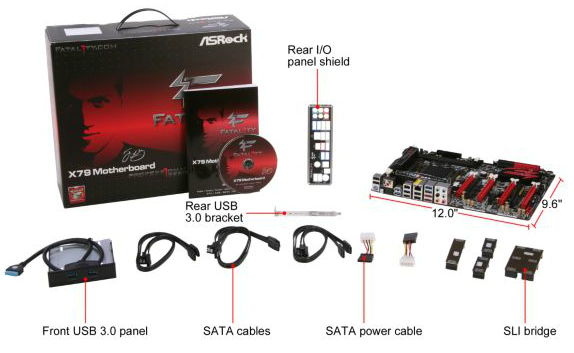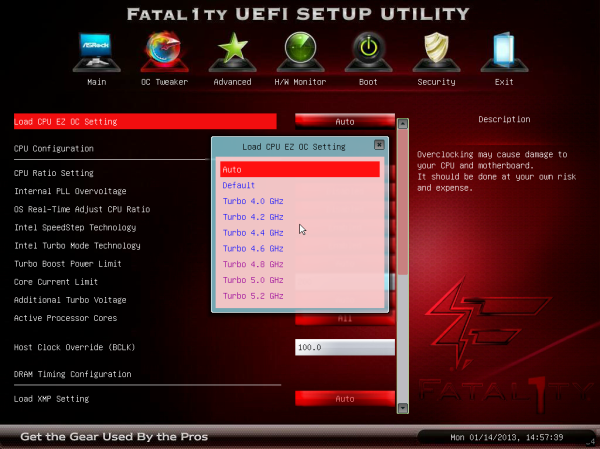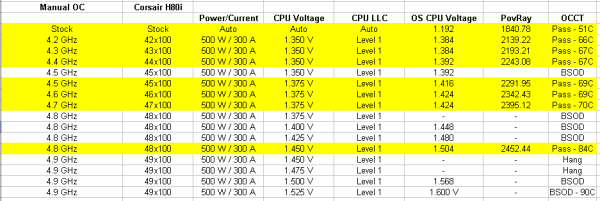ASRock Fatal1ty X79 Champion and X79 Professional Review: From a Gamer to Gamers
by Ian Cutress on February 9, 2013 10:30 AM EST- Posted in
- Motherboards
- ASRock
- Fatal1ty
- X79
ASRock X79 Professional In The Box
As we move down a range of motherboards from a single vendor in terms of price, the only change worth expecting in terms of box contents is usually a decrease in number, or elimination of high-end specific/low-end novelties. At $265, the Professional is still a large investment for any build, meaning we still expect some depth and range in the package itself. Given that the Champion and Professional support 4-way GPU configurations, I would safely assume given what the Champion provided that the Professional will also supply sufficient SLI Bridges.
From the Professional we get:
Driver CD
User Manual
Rear IO Shield
Six SATA Cables
Two Molex to SATA Power Cables
Two 2-slot Rigid SLI Bridges
One 3-slot Rigid SLI Bridge
One 2-slot Rigid 3-way SLI Bridge
USB 3.0 Front Panel with Rear Bracket included

The only difference between the Professional and the Champion is the Professional lacks the 3-slot rigid 3-way SLI bridge because the PCIe layout does not allow such a configuration. Despite this, the motherboard still has four SLI bridges when a single rigid 4-way would have been sufficient for all NVIDIA configurations.
ASRock X79 Professional Overclocking
Experience with Professional X79 Professional
In comparison to overclocking with the Champion, the Professional achieved a higher overclock at a lower voltage and a lower temperature. It feels very weird to say that for two boards that are near identical, the cheaper one offers a better overclocking experience. A possibility for this could relate to the reduction of functionality from the Champion to the Professional, or that the Professional has had more input on the BIOS side (latest versions at testing time was P2.30 for the Professional and P1.90 for the Champion).
Nevertheless, the ASRock boards still fall down on the OS overclock implementation – no list of automatic overclocks from software, and the OC implementations in software are lacking at best, especially when put side by side with the competition, such as ASUS. The BIOS overclocking options are however well laid out, easy to use, and provide a large number of automatic options to help any user on their overclocking journey.
Methodology:
Our standard overclocking methodology is as follows. We select the automatic overclock options and test for stability with PovRay and OCCT to simulate high-end workloads. These stability tests aim to catch any immediate causes for memory or CPU errors.
For manual overclocks, based on the information gathered from previous testing, starts off at a nominal voltage and CPU multiplier, and the multiplier is increased until the stability tests are failed. The CPU voltage is increased gradually until the stability tests are passed, and the process repeated until the motherboard reduces the multiplier automatically (due to safety protocol) or the CPU temperature reaches a stupidly high level (100ºC+). Our test bed is not in a case, which should push overclocks higher with fresher (cooler) air.
Automatic Overclock:
Due to the lack of automatic overclock settings in the OS and software, we delve straight into the BIOS. We are offered overclocks from 4.0 GHz to 5.2 GHz, in 200 MHz intervals – these options recall a pre-programmed table of settings and apply them in the BIOS.
The results are as follows:
The options and settings for the Professional mirror those of the Champion as one would expect, however as noted, the automatic settings on the Professional are stable one notch higher than those of the Champion.
Manual Overclock:
Using the automatic overclock settings as a guide, the following options were selected for the manual overclocks:
Power Limits: 500 W
Current Limit: 300 W
Load Line Calibration: Level 1
PLL Overvoltage: Enabled
Starting at 4.2 GHz and 1.350 volts as set in the BIOS, the system was tested for stability, moving up in multiplier when successful and moving up in voltage when unsuccessful. Our results are as follows:
There are a couple of results worth noting.
On the Professional, the load OS voltage (when using a Load Line Calibration of Level 1) is clearly miles above what is actually set in the BIOS. For example, at our 4.8 GHz stable setting, at load in the operating system showed 1.504 volts, compared to only 1.450 volts in the BIOS. That is a crazy difference, and I have no understanding of why ASRock would program it this way, especially when the Champion by comparison does a near 1:1 application of setting and load.
As a result of our overclocking, the system was successfully stable at a lower range of voltages as set in the BIOS. The Professional was stable at 4.7 GHz with only 1.375 volts in the BIOS (1.424 volts at OS load) compared to the Champion which required 1.525 volts (1.520 volts at OS load). This is a large difference, indicated by a load temperature of 70C on the Professional to 91C on the Champion.













71 Comments
View All Comments
lukarak - Tuesday, February 12, 2013 - link
Citroen C4 by Loeb? Sporty as hell :D :DMithan - Sunday, February 10, 2013 - link
A waste of money, like all these "performance" series boards designed to get an extra $100 out of you for a 3% increase in speed.Sorry, but I will always buy a board in the $140-160 range, and take that extra money and dump it into a better video card.
CeriseCogburn - Wednesday, February 13, 2013 - link
This board appears to be not worth it, as it falls short too much, too often.Others do not.
A poor boys budget means never getting something great, and that's okay to suffer in the underclass.
althaz - Monday, February 11, 2013 - link
Where is the Day[9] CPU heatsink or the Tastosis keyboard/mouse combo? Or the JP calendar?ypsylon - Monday, February 11, 2013 - link
For starters I couldn't force myself to buy any motherboard with black&red theme. Bleeeh. Red as a color make me sick. Anyway that is only personal distaste. But that is not the only thing which is wrong with those boards. 1. 8 USB3 ports. Adding so many to the back panel is nothing short of idiotic. A lot of supposedly compatible hardware of USB2 fame doesn't work when connected to USB3. Every motherboard -equipped with USB3- I tested/owned displayed same stubbornness with one device or another. Some USB2 devices just refused to work outright on USB3. Period. 2. Board which cost 350$+ and doesn't have Intel NIC = joke. 3. Professional have better balanced I/O panel, but it is also stripped down when compared to "Champion". There is nothing "Professional" about supposed professional board. 4. Endorsement by a bloke which for most modern PC users means absolutely nothing is also nothing short of laughable. I think AsRock would do better releasing "Justin Biber" board. Then maybe some brainless teens will buy it only because it is JB board. 5. Both boards also share same problem with top 16 PCI-Ex slot (of course it is not native only to those 2 products, but must be pointed out). Can't remove memory sticks without removing VGA, large dual tower coolers also can be an issue. Think before releasing product. If you desperately want quad-SLI/CF setup release XL-ATX board. On such board there is enough space for everything.Oh and these red slots/ports, bleeeh. Did I mention that earlier? :P
lukarak - Monday, February 11, 2013 - link
You do know that you can insert DIMMs with just one latch moveable. Especially on these, where there is only one moveable to begin with.Endorsement by a bloke is no more or less idiotic than every other marketing thing. From Republic of Gamers, Lanparty series boards with UV cable sleeves and a chasis carrying strap and so on. It all adds to the price of an otherwise fine board, but that's their calculation.
You also have USB 2.0 ports on the back side, for that occasional peripheral that doesn't work. Plus six of them on headers which you can, imagine the surprise, route to the back side as well.
Peanutsrevenge - Monday, February 11, 2013 - link
The designs are always far too aggressive and garish for my tastes, which is annoying as often the products are just what I'm after - spec wise.Gamer stuff does NOT have to be all aggressive and such, opponents will only see the equipment of LAN gamers, which is a tiny percentage of us.
For the majority of us, the system sits at home and plays multiple roles and even requires the WAF in very very rare cases (usually Mum Acceptance Factor).
sking.tech - Monday, February 11, 2013 - link
I've never purchased a fatal1ty product because often they are too expensive and show no real performance gains vs a lot less expensive competitors. Now that I know it's based on some has-been gamer. Even less likely to ever buy a product with this brand on it. This Article - greatly appreciated.Bonesdad - Monday, February 11, 2013 - link
What drives me nuts is how they try to make him look like a tough guy...like he's some badass keyboard bangin, mouse clickin gangsta.maximumGPU - Tuesday, February 12, 2013 - link
Hahah